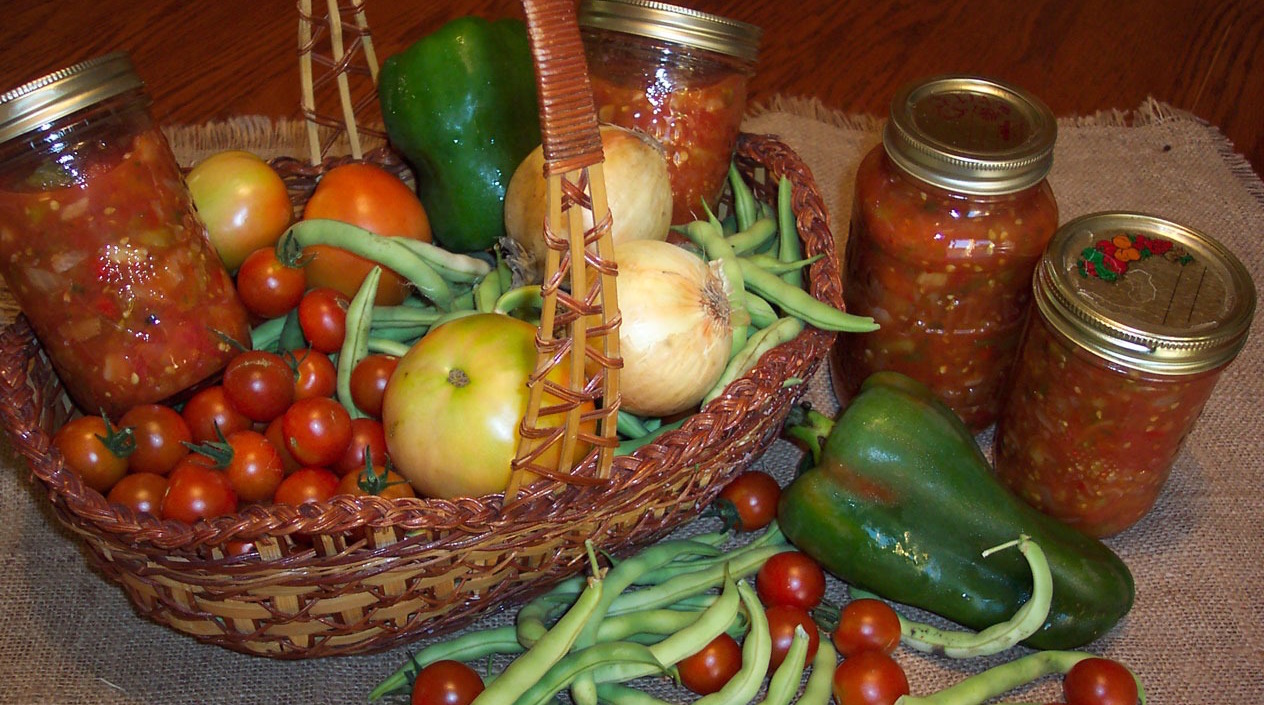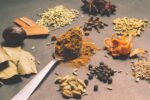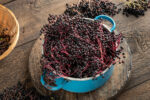
Pickled Tomatoes, Chutney, Mince, Catchup & more
In the 1800s, people could only eat food in season unless they preserved it. Around 1860, home canning become popular because a tin smith, John L. Mason invented a glass jar with a threaded lip and a reusable metal lid: the Mason Jar.
This new canning jar allowed people to safely can fruit, pickles, relishes, and sauces like ketchup. However, canning low-acid vegetables and meat was still too dangerous. SOURCE
INFORMATION BELOW FROM 1800s COOKBOOKS
PICKLING TOMATOES
Scald* and peel a peck* of ripe tomatoes. Lay them on dishes, and strew salt thickly over them. Let them stand for twenty-four hours, occasionally pouring off the liquor that the salt extracts. Then drain them on a sifter, and gently squeeze them, as it is this juice that weakens the vinegar and makes the pickles spoil.
Take a large jar, put in a layer of tomatoes, then a layer of sliced onions, mustard seed, cloves and white pepper, or whole black pepper (you may if you like, break two pods of red pepper and put in each jar.) When the jar is full, pour very strong vinegar over, and in a few days they will be ready for use, and will keep all winter. They retain much of the tomato flavor, and should be kept in a cool place.
*scald – to heat liquid almost to a boil, until bubbles begin to form around the edge.
*peck – measurement for dry volume; a peck is two gallons or eight dry quarts. Four pecks make a bushel.
Another Way.
Take small round tomatoes when they are not too ripe. Stick them with a needle in several places to keep the skin from bursting, and let them lay a week in salt and water. Then wash them and put them in a jar with some cloves, pepper and small onions. Cover them with strong cold vinegar, and tie up the jar.
SWEET TOMATO PICKLE
Slice one gallon green tomatoes, and put a handful of salt to each layer of tomatoes. Let them stand twelve hours, then drain off the liquor, and add to them two green peppers, and two to four onions, sliced. Take two quarts vinegar, one-half pint molasses, two tablespoons mustard, one teaspoon allspice, and one of cloves. Heat it until it begins to boil, then put in the tomatoes, onions, and peppers. Let them boil ten minutes, pour into a stone jar, and seal tight. In a fortnight* they will be ready for use.
*fortnight – a period of two weeks.
TO MAKE PICCALILLI
To one-half bushel nicely chopped tomatoes, which must be squeezed dry, add two dozen onions, chopped fine, one dozen green peppers, chopped, one box ground mustard, one large root horseradish, nearly one pint salt, four tablespoonfuls ground cloves, and four tablespoons allspice. Mix thoroughly in a stone jar and cover with vinegar, making a hole in the center of the mixture to let the vinegar go to the bottom.
TOMATO CHUTNEY
Take one peck of green tomatoes, six large green peppers, six onions, and one cup of salt. Chop onions and peppers fine, slice the tomatoes about a quarter of an inch thick, and sprinkle the salt over all. In the morning drain off all the salt and water, and put the tomatoes in a porcelain-lined kettle. Mix together thoroughly two pounds brown sugar, one-fourth pound mustard-seed, one ounce each of powdered cloves, cinnamon, ginger, and black pepper, one-half ounce allspice, and one-quarter ounce each of cayenne pepper and ground mustard. Stir all into the tomatoes, cover with cider vinegar—about two quarts—and boil slowly for two hours. Very nice, but very hot. If wanted less so, omit the cayenne and ground mustard.
TOMATO CATCHUP
Boil one bushel of ripe tomatoes, skins and all, and when soft, strain through a colander. Be sure that it is a colander, and not a sieve, for reasons to be given. Add to this pulp two quarts of best vinegar, one cup of salt, two pounds of brown sugar, half an ounce of cayenne pepper, three ounces each of powdered allspice and mace, two ounces of powdered cinnamon, and three ounces of celery-seed. Mix spices and sugar well together, and stir into the tomato. Add the vinegar, and stir thoroughly.
Now strain the whole through a sieve. A good deal of rather thick pulp will not go through. Pour all that runs through into a large kettle, and let it boil slowly till reduced one-half. Put the thick pulp into a smaller kettle, and boil twenty minutes. Use as a pickle with cold meats or with boiled fish. A teacupful will flavor a soup. A pint of brandy is added ten minutes before the catchup is done. It is not necessary, though an improvement. Bottle, and keep in a cool, dark place. It keeps for years.
NOTE: I’ve seen three ways of spelling this word in various 1800s cookbooks: catchup, catsup, and ketchup.
GREEN TOMATO MINCE FOR PIES
Cut one-quarter peck green tomatoes in small pieces and then sprinkle with three tablespoons of salt. Place in a square of cheese-cloth and then tie up and hang where it can drain all night. In the morning place a one and one-half pound can of corn syrup in a saucepan and add one-half pound of brown sugar, one tablespoon of cinnamon, one teaspoon of nutmeg, one-half teaspoon of allspice, one-half teaspoon of ginger, two packages of raisins, and one-half cup of salad oil. Bring the mixture to a boil and then cook slowly for one-half hour. Fill into jars and then process in a hot-water bath for twenty minutes. Seal and test for leaks. Store in a cool, dry place. This makes a delicious pie filling.
CANNED TOMATO SOUP
Fourteen quarts of sliced ripe tomatoes.
Fourteen stalks celery.
Fourteen sprigs parsley.
Two bay leaves.
Twenty-one cloves.
Seven medium sized onions.
Boil until tender and strain. Then blend fourteen tablespoons each of butter and flour, eight tablespoons salt;,sixteen tablespoons sugar, and one-fourth tablespoon paprika. Cook until the desired thickness. Makes about eight quarts. If milk is used, add soda*.
*soda – baking soda
CHILI SAUCE
One peck tomatoes.
Six large onions.
Four green peppers.
Two red peppers.
Six tablespoonfuls white sugar.
Three tablespoonfuls salt.
Three cups vinegar.
Two tablespoons whole cloves.
Two tablespoonfuls whole allspice.
Two stalks whole cinnamon.
Chop tomatoes, pepper and onions, very fine; Tie spices in two bags, loosely. Boil three hours, slowly.
=================================================
Do You Like Tomatoes? How Do You Use Them? Please Leave a Comment Below.
=================================================
BOOKS YOU MAY LIKE:
Preserving Food without Freezing or Canning: Traditional Techniques Using Salt, Oil, Sugar, Alcohol, Vinegar, Drying, Cold Storage, and Lactic Fermentation
Typical books about preserving garden produce nearly always assume that modern “kitchen gardeners” will boil or freeze their vegetables and fruits. Yet here is a book that goes back celebrating traditional but little-known French techniques for storing and preserving edibles in ways that maximize flavor and nutrition.

From the experts at Jarden Home Brands, makers of Ball canning products, comes the first truly comprehensive canning guide created for today’s home cooks. This modern handbook boasts more than 350 of the best recipes ranging from jams and jellies to jerkies, pickles, salsas, and more-including extender recipes to create brand new dishes using your freshly preserved farmer’s market finds or vegetable garden bounty.
=================================================





4 thoughts on “Pickled Tomatoes, Chutney, Mince, Catchup & more”
Would dearly love to find a recipe at least close to the one my Grandmother used to make..She would put spam on toast and stick it under the broiler then top it with her tomato relish..So good, and I remember it being sweet…She used to can; unfortunately I’m a bit scared to…..She was a WW1 kid so I imagine this recipe goes way back.
I did a quick search and found that “Spam was first introduced in 1937 and gained popularity worldwide after its use during World War II.” (Wikipedia). Her relish recipe could have been much older, though, and she adapted it to create a recipe for Spam.
Wow! Two cups of brown sugar! No wonder so many people like catsup. Interesting post as usual.
I don’t normally think of catsup as sweet, but it is.